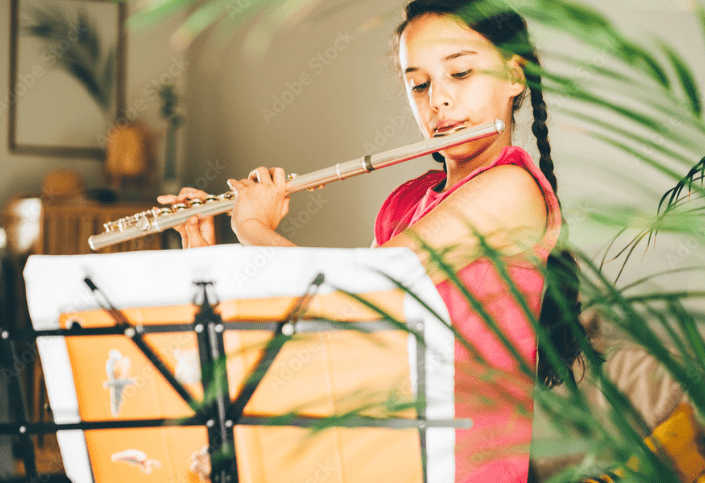This article was first written in February 2011, and has been updated for December 2024.
Not every flute is made equal, and buying your first instrument can be daunting. There are so many different makes, models and types of flutes available, and the variations in price can be hundreds of pounds. Below, we’ve compiled our top tips to help a complete newcomer decide on a new flute.
1. Choose the brand wisely
First off, you’re not buying a commodity like a TV or a laptop which just works out of the box. Flutes are finely-engineered mechanical items, with more in common with a motorbike than a microwave; it needs to be well-made with high-grade metal parts which won’t wear quickly. Not only that, but it needs to be easy to play and repairable.
There are plenty of good flutes available, but there are also plenty of horrors which you will want to avoid. Here are some pointers to help you separate the concerto-worthy brands from those more likely to cause a cacophany:
- Is the brand only listed on a handful of marketplace websites such as Amazon and eBay? Ignore the 5-star reviews, which are largely fake – these are usually made of low-grade metal, often nickel-plated (which, as well as being an allergen, is highly polluting to manufacture), and difficult to play.
- Does the manufacturer have its own website? This is a promising sign that they will have after-care available.
- Is the brand listed for sale with specialist woodwind shops? Shops don’t want the hassle of dealing with lots of faulty instruments or returns, so if a brand is near universally stocked, this is a huge vote of confidence from the music retail industry.
2. Be careful of flutes which look too cheap…
Some supermarkets, high street chains and marketplaces now sell their own brand of flutes. In our experience, these flutes should be avoided: while the quality of Chinese flutes has undoubtedly improved since this article was originally written in 2011, there are still too many poor-quality, cheap flutes around.
While your initial outlay will be low, the running costs will quickly overtake the price of a better-made flute. A £100 flute is suddenly not that much of a bargain when you’re spending £50 every few months to get it repaired (and yes, this is a scenario we have witnessed on many occasions).
▶️ Watch: Buying on a Budget
Apart from their high operating costs, cheap flutes present challenges in terms of playability and sound quality, even for advanced players. Many people have found themselves struggling with the flute, thinking they lacked skill and were on the brink of giving up, only to discover that the problem was actually due to using a low-quality instrument.
Our own-brand budget flute may be priced a fraction higher than the very cheapest flutes available – but it has been designed by flute players (us!) and you can be confident that it will give a student a great start.
Budget: We recommend that you should budget between £300 – £550 for an entry-level flute, although Take It Away (for UK residents) and buying second hand can help to reduce the up-front strain on your wallet.
3. …But don’t buy something that’s not designed for a beginner
Not all flutes are suitable for newbies, so we advise against getting something higher priced – it should go without saying that flutes which have been classified as ‘beginner flutes’ by the big brands have been designed specifically for student players. A good quality beginner flute should be easy to play, lightweight, and be able to withstand knocks and bumps.
On the other hand, step-up flutes, professional flutes and so on, have been designed for players who can already play the flute to an extent. They’re not designed to be as easy to play, but they don’t need to be – they assume some level of competence, and tend to be heavier, offering a fuller sound and increased projection that an advanced player needs, but with more effort required.
4. Stick to ‘traditional’ specifications
There’s a whole raft of options available on flutes. Open holes, C# trill keys, E mechanism, B footjoint, D# roller, silver this or that.
In our opinion, a beginner should start on a silver-plated flute with closed holes, E mechanism (sometimes called a Split E) and C footjoint. If you want to know what these terms mean, read our Jargon Buster, but basically a flute with these specifications will be (a) easier to play and (b) easier to re-sell at a higher value when the time arises.
By the way: If a flute advert lists the number of keys it has, you’d be well-advised to steer away. This is not how flute experts advertise their instruments!
5. Get the right size
Flutes don’t come in different ‘sizes’ as such, but you can get curved headjoints for a small beginner. This brings the keys of the flute closer to the body, reducing the stretch. If your child needs a curved headjoint, the truth is that it will cost more; but the problems if you don’t get a curved headjoint could far outweigh the price difference. Neck and back pain from over-stretching can arise, and players can easily get into the bad habit of poor posture. It can take many years to sort out a poor posture that wouldn’t have arisen with a curved headjoint.
For very small players (ages 5 to 7), you could start on the fife or Apprentice flute, both of which are affordable ‘mini’ flutes.
➡️ Read: Starting Your Child on Flute: How Young is Too Young?
▶️ Watch: Flutes for Small Beginners
6. A good brand will hold its value
Unlike many things today – cars, computers, phones etc – a new flute can hold its value well for years. Many model numbers have been around for a long time – so you shouldn’t worry about your flute being obsolete in six months’ time. In fact, because of increasing metal prices, some people have been lucky enough to discover that a Yamaha 212 flute bought new a few years ago is now worth more second hand than they paid new!
7. Think ahead
When choosing a beginner flute, it’s worth considering one that will support your progress as you develop your skills and sound. While there is often a trade-off between ease of play and sound quality, certain models, such as the Jupiter JFL-700EC and Yamaha YFL-212, strike an excellent balance. These flutes are not only easy to play but also produce a good tone, making them well-equipped to handle the demands of more advanced music as you improve.
Follow this advice and you’ll have an instrument that will give years of use and enjoyment. What’s more, it will give you room to develop your playing skill, too.
Now that you know what you are looking for, view the selection of beginner flutes on offer at Just Flutes


